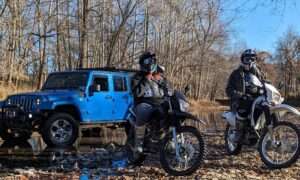Our Field Operations Guide (FOG) highlights the essential knowledge and guidance needed to keep safe out in the field. In this guide, we’ll cover guidelines for radio communications, setting up community camp, weather safety, and more.
Radio Communications

The Dirt Nerds & Radios Radio Club provides guidance to our community members on how best to stay in touch when exploring the great outdoors. The Radio club helps our community learn to use radios to communicate with each other, but they also help us share important information and stay safe. Unlike cell phones, amateur radios work even when we are far away from city services, making them a reliable way to keep in touch.
Anytime we set up at camp, we have a radio within earshot. The Camp comms station is always available. You can reach out to club members for assistance in finding the group, setting up your tent, or locating resources. Camp Comms are available on UHF/VHF, both FM(Analog) & DMR(Digital). Typically, HF frequencies are not planned. HF usage at camp is limited so if you need guidance for HF camp comms, please reach out.
Dirt Nerds & Radios Radio Club uses the Adventure Radio Protocol & the North America Adventure Frequency when on trail. Read more about Adventure Radio protocol at Sierra Radio Systems. Adventure Radio Protocol takes advantage of CTCSS Tones to allow a single frequency to be used for multiple purposes. The Adventure Radio Protocol reserves all CTCSS tones between 67.0 Hz and 151.4 Hz. Radio operators may use any CTCSS frequency above 151.4 Hz for any other purpose.
A full link to our current comms plan can be found here. Any questions or requests for update can be made via #ham-radio on our Discord.
Community Camp

When choosing a campsite for a group, it’s important to find a safe location that suits the needs of that particular trip. Make sure to look for a spot close to planned activities with enough space for everyone’s tents. The area should be easy to reach and free of hazards like flooding or steep slopes. Make sure the ground is relatively flat, shade or wind protection if available, and the site is large enough to provide room for camp activities without overcrowding. Make sure to secure any necessary permits ahead of time.
It’s also essential to consider resources like water, firewood, and restroom facilities. Identify how much water & firewood you will need and make sure to have it on hand before getting to camp. Also make sure to keep your current group’s comfort levels in mind, ensuring the site is suitable for all and allows for the group to complete their planned activities.
Lastly, we try hard to Tread Lightly & follow Leave No Trace principles. This means minimizing our environmental impact and packing out all waste. If possible, try to clean up any additional waste found while at camp or on the trail. If we wish to continue to experience and enjoy the natural resources available to us, we have to do our part to take care of them.
Weather Safety

When it comes to understanding the weather, we rely heavily on the National Weather Service (NWS). With both public weather radio broadcasts and training available to the public, it’s pretty easy to stay “weather aware.”
Always keep an eye out for darkening skies, sudden drops in temperature, or rising winds, as these can signal an approaching thunderstorm. Any Heavy rain could lead to flash flooding, especially in low-lying areas or near rivers and streams. This flooding is both a potential risk to our campsites and to safe trail travel. Lightning is also a risk, so avoid open spaces, tall trees, and metal objects during a thunderstorm. Any antennas constructed for radio operation should be taken down, or at a minimum disconnected from equipment for safety.
In the 1970s, The NWS established the volunteer SKYWARN. This is a volunteer program, providing critical local weather information with between 350,000 and 400,000 trained severe weather spotters today. These volunteers help keep their local communities safe by providing timely and accurate reports of severe weather to the National Weather Service. Training classes for the SKYWARN program are free and typically last two hours. Training typically includes:
- Thunderstorm Development Basic
- Storm Structure Fundamentals
- How to identify potential severe weather
- Basic Severe Weather Safety
- What & How to report information to the NWS
Classes are available both in-person and online. To find a class in your area, check the NWS website a link to your local SKYWARN Program. Classes are also available online.
Trails & Offroad

When serving as a trail guide for off-road vehicles, it’s important to ensure the safety, organization, and enjoyment of everyone in the group. A key principle to remember is that no one gets left behind—ever. The ride isn’t over until every participant has successfully completed the trail. To help the group stay coordinated, it’s essential to arrange the vehicles in a reasonable and logical order. Smaller vehicles, like dirt bikes, should ride at the front of the group. These vehicles can act as informal scouts, identifying obstacles or challenges on the trail and providing valuable information to the rest of the riders.
Another critical aspect of leading an off-road group is preparing for potential recovery situations. Before heading out, evaluate the vehicles in the group and make sure there are adequate recovery tools and plans for all types of vehicles. This includes everything from winches to tow straps and ensuring that the group knows how to use them if needed. By focusing on these core principles—staying together, organizing effectively, and preparing for recovery—you can create a safer, more enjoyable off-road experience for everyone involved.
